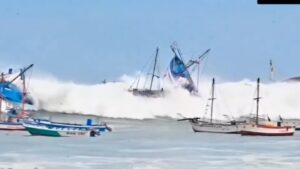The coasts of Peru, Ecuador, and Chile were hit by unusually violent waves, a swell that claimed the lives of three people and led to the closure of most Peruvian ports.
The waves exceeded four meters in Peru and two meters in Ecuador, according to authorities in both countries.
The head of Ecuador’s risk management secretariat, Jorge Carillo, called during an interview an “extreme” phenomenon and warned that similar ones could reappear in the future.
“Unfortunately, we have recorded two deaths,” both in Manda (southwest), he added.
In addition, according to the Chilean navy, a 30-year-old man died in the north of the country, on a beach in the town of Iquique, where civilians had been banned from going swimming and a high-wave warning had been issued, valid until Tuesday.
Off Peru, 31 fishermen stranded at sea were rescued by the navy and taken to the town of Tubes (northwest), according to the press.
One of them, however, told Exitosa radio station that at least 180 of his colleagues remained stranded at sea.
“The food ran out, the water ran out. Our brother fishermen are practically on rudderless boats. We need oil, food for the children and a naval presence. The ships are drifting because they have no fuel,” he noted.
In Peru, 91 of the country’s 121 ports were closed from the day before yesterday, Saturday, to the day after Wednesday, and restrictions were imposed on access to beaches, the National Emergency Operations Center (COEN) said via X.
According to a warning issued by the same institution on Friday, the tide was expected to last until Wednesday, January 1, affecting several areas, from north to south.
The municipality of Cayao, Peru’s largest port, a short distance from the capital Lima, banned access to all beaches in its jurisdiction and closed the iconic seafront Grau Square, which was completely flooded.
“We have a big problem. These waves are not like other waves. And those who are most affected are the fishermen,” said Roberto Carillo Savala, mayor of La Cruz (north), who flew by helicopter to the coastal area with Defense Minister Walter Astudillo Chavez.
The waves damaged dozens of floats and commercial establishments near beaches, according to visual footage broadcast. Damage was reported in several coastal towns, where many residents fled.
“This tide is being generated thousands of kilometers away from Peru, off the U.S. coast, by persistent wind on the ocean surface moving towards our coast,” Peru’s PN Captain Enrique Vareja told Canal N.
The oceanographic and antisubmarine institute of the Ecuadorian navy said the natural phenomenon translates into “higher than average”, continuous, and “long-lasting” waves caused by distant storms that move across the Pacific Ocean until they “reach our shores.”
Climate change is “causing this kind of unnatural swell,” Larry Lynch, in charge of the civil protection secretariat in the municipality of Kayo, told the French Press Agency. Strong winds in the direction of the coast further increased the level of the tide in the area.
Ask me anything
Explore related questions





